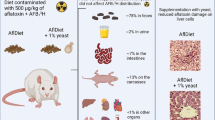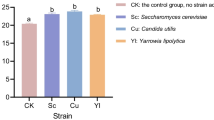Abstract
Although the effects of aflatoxin on animal performance have been well established in previous studies, there are few studies reporting on the relationship between aflatoxin and Saccharomyces cerevisiae. The ability of Saccharomyces cerevisiae to minimize aflatoxicosis was evaluated. An aflatoxin-free diet and six contaminated diets (400 μg kg−1 aflatoxin) were formulated with five diets containing the viable yeast (Y1026 or Y904). A 28-day bioassay using 21-day-old and 60-g body weight Wistar rats was conducted. The results showed that there were no significant (P > 0.05) differences for: food consumption; daily weight gain; food conversion, and enzyme activity. Hepatic tissues from the aflatoxin control group suffered from hepatotoxicity, cellular disorganization, and hepatocyte necrosis. The inclusion of yeast or yeast and amino acids (methionine and cysteine) reduced the toxicity.







Similar content being viewed by others
References
Angier N (1986) A stupid cell with all the answers. Discover 7(11):71–83
Baptista AS, Horii J, Gloria EM et al (2001) Saccharomyces cerevisiae in the reduction of the aflatoxins effects. Eur J Pham Sci 13(Supl 1):S.48
Baptista AS, Horii J, Calori-Domingues MA et al (2004) The capacity of mannanoligosaccharides, thermolysed yeast and active yeast to attenuate aflatoxicosis. World J Microbiol Biotechnol 20(5):475–481. doi:10.1023/B:WIBI.0000040397.48873.3b
Barnes JM, Butler WH (1964) Carcinogenisis activity of aflatoxin in rats. Nature 202(493):1016. doi:10.1038/2021016a0
Beudeker R (1990) Developments in baker’s yeast production. In: Veracheterl H, De Mot R (eds) Yeast: biotechnology and biocatalysis. Marcel Dekker Inc., Nova Yorque, pp 103–146
Bloksma N, De Heer E, Van Dijk H et al (1979) Adjuvancy of lactobacilli. I. Differential effects of viable and killed bacteria. Clin Exp Immunol 37(2):367–375
Bradburn N, Coker RD (1993) Aflatoxin contamination in maize. Trop Sci 33(44):418–428
Celik K, Denli M, Erturk M, Ozturkcan O et al (2001) Evaluation of dry yeast (Saccharomyces cerevisiae) compounds in the feed to reduce aflatoxin B-1 (AFB(1)) residues and toxicity to Japanese quails (Coturnix coturnix japonica). J Appl Anim Res 20(2):245–250
Celik K, Denli M, Savas T (2003) Reduction of toxic effects of aflatoxin B1 by using baker yeast (Saccharomyces cerevisiae) in growing broiler diets. Rev Bras Zootec 32(3):615–619
Cornelius CE (1963) Liver function. In: Cornelius CE, Kaneko JJ (eds) Clinical biochemistry of domestic animal. Academic Press, New York, pp 255–301
Crumplen R, D’Amore T, Panchal CJ, Russell I et al (1989) Industrial uses of yeast: present and future. Yeast 5(1):3–9 (special issue)
Dickens F, Jones EH (1963) The carcinogenic action of aflatoxin after its subcutaneous injection in the rats. Brit J Cancer 17(4):691–698
Edds GT, Bortell RA (1983) Biological effects of aflatoxins: poultry aflatoxin and Aspergillus flavus in corn. In: Diener UL, Asquitz RL, Dickens JW (eds) Bulletin of the Alabama agricultural experiment station. Agricultural Experiment Station, Aubum University, Alabama, pp 64–66
Ellis WO, Smith JP, Simpson BK et al (1991) Aflatoxins in food: occurrence, biosynthesis, effects on organisms, detection, and methods of control. Crit Rev Food Sci Nutr 30(4):403–439
Eppley RM, Truckness MW, Nesheim S et al (1986) Determination of deoxynivalenol in wheat—collaboraty study. J Assoc Off Anal Chem 69(1):37–40
FAO (1993) Sampling plans for aflatoxin analysis in peanuts and corn. Roma, pp 1–75
Fernandes CF, Shahani KM, Amer MA (1987) Therapeutic role of dietary lactobacilli and lactobacillic fermented dairy products. FEMS Microbiol Rev 46(3):343–356. doi:10.1111/j.1574-6968.1987.tb02471.x
Fortnum BA (1986) Effect of environment on aflatoxin development in preharvest maize. In: Zuber MS, Lillehoj EB, Renfro BL (eds) Aflatoxin in maize: a proceedings of the workshop. CIMMYT, El Batan, pp 145–151
Frisvad JC, Thrane U (1996) Mycotoxin production by food-borne fungi. In: Samson RA (ed) Introduction to food-borne fungi. CBS, The Netherlands, pp 251–260
Fuller RE (1992) History and development of probiotics. In: Fuller R (ed) Probiotics—the scientific basis. Chapman and Hall, London, pp 1–8
Galvano F, Piva A, Ritieni A, Galvano G (2001) Dietary strategies to counteract the effects of mycotoxins: a review. J Food Prot 64(1):120–131
Gawai KR, Vodela JK, Dalvi PS et al (1992) Comparative-assessment of the effect of aflatoxin-b1 on hepatic-dysfunction in some mammalian and avian species. Comp Biochem Physiol C Pharmacol Toxicol Endocrinol 101(2):415–418
Hamilton PB (1984) Determining safe concentrations of mycotoxins. J Food Protect 47(7):570–575
Heathcote JG (1984) Aflatoxins and related toxins. In: Betina V (ed) Mycotoxins, production, isolation, separation and purification. Elsevier, Amsterdam, pp 89–130
Heathcote JG, Hibbert JR (1978) Aflatoxins: chemical and biological aspects. Elsevier Science, New York
Herzberg PA (1990) How sas work. Captus Press, Canada, pp 1–193
Huff WE, Kubena LF, Harvey RB et al (1986) Progression of aflatoxicosis in broiler chickens. Poultry Sci 65(10):1891–1899
Jones FT, Hagler WM, Hamilton PB (1982) Association of low concentrations of aflatoxin in feed with productivity losses in commercial broiler operations. Poultry Sci 61(5):861–868
Kato I, Kobayashi S, Yokokura T et al (1981) Antitumor activity of Lactobacillus casei in mice. Gann 72(4):517–523
Krause OG, Richardson CR, Castleberry RE et al (1989) Biological response of chicks fed sorghum grain based diets with added grain specific enzymes mixture and yeast. Tex Technol Agric Sci 5:727–735
Kubena LE, Harvey RB, Phillips TD et al (1990) Diminution of aflatoxicosis in growing chickens by the dietary addition of a hydrated sodium calcium aluminosilicate. Poultry Sci 69(5):727–735
Lillehoj ED (1986) The aflatoxin in maize problem: the historical perspective. In: Zuber MS, Lillehoj EB, Renfro BL (eds) Aflatoxin in maize: a proceedings of the workshop. CIMMYT, El Batan, pp 13–32
Nichols TE (1983) Economic effects of aflatoxin in corn. In: Diener R, Asquith R, Dickens J (eds) Aflatoxin and Aspergillus flavus in corn. Auburn University, Auburn, pp 67–71
Pacheco AC (1981) Basic compendium hystological techniques (in Portugueses). University of the state of São Paulo (UNESP), Botucatu, SP, Brazil, pp 1–31
Parlat SS, Ozcan M, Oguz H (2001) Biological suppression of aflatoxicosis in Japanese quail (Coturnix coturnix japonica) by dietary addition of yeast (Saccharomyces cerevisiae). Res Vet Sci 71(3):207–211
Perdigon G, Alvarez S (1992) Probiotics and the immune state. In: Fuller R (ed) Probiotics—the scientific basis. Chapman and Hall, London, pp 146–180
Pierce JS (1970) Analysis committee measurement of yeast viability. J Inst Brew 76(5):442–443
Pozzi CR (2000) Efeitos da adminstração prolongada de Fumonisina B1 e Aflatoxina B1 em ratos (Rattus norvegicus). Tese Doutorado, Instituto de Ciências Biomédicas, Universidade de São Paulo, São Paulo, 179 pp
Raju MVLN, Devegowda G (2002) Esterified-glucomannan in broiler chicken diets contaminated with aflatoxin, ochratoxin and T-2 toxin: evaluation of its binding ability (in vitro) and efficacy as immunomodulator. Asian-Australas J Anim Sci 15(7):1051–1056
Reeves PG, Nielsen FH, Fahey GC (1993) Ain-93 purified diets for laboratory rodents—final report of the American Institute of Nutrition ad hoc writing committee on the reformulation of the ain-76a rodent diet. J Nutr 23(11):1939–1951
Saavedra JM, Bauman NA, Oung I et al (1994) Feeding of Bifidobacterium bifidum and Streptococcus thermophilus to infants in hospital to prevention of diarrhea and shedding of rotavirus. Lancet 344(8929):1046–1049
Sawada H, Furushiro M, Hirai K et al (1990) Purification and characterization of an antihypertensive compound from Lactobacillus casei. Agric Biol Chem 54:3211–3219
Smith JE, Moss MO (1985) Mycotoxins: formation analysis and Significance. Chichester, New York, pp 1–148
Soares LMV, Rodrigues-Amaya DB (1989) Survey of aflatoxins, ochratoxin A, zearalenone and sterigmatocystin in some Brazilian food by using multi-toxin thin-layer chromatographic method. J Assoc Off Anal Chem 72(1):22–26
Stanley VG, Ojo R, Woldesenbet S et al (1993) The use of Saccharomyces cerevisiae to suppress the effects of aflatoxicosis in broiler chicks. Poult Sci 72(10):1867–1872
Yiannikouris A, Poughon L, Cameleyre X et al (2003) A novel technique to evaluate interactions between Saccharomyces cerevisiae cell wall and mycotoxins: application to zearalenone. Biotechnol Lett 25(10):783–789
Acknowledgments
The authors would like to thank Mr. Lécio Aparecido Castilho of the Animal Nutrition Laboratory USP/CENA/lANA, for helping with the bioassays and Mrs. Ivani V. Zambello of the Mycotoxin Laboratory USP/ESALQ/lAN, for her help in analyzing the aflatoxin.
Author information
Authors and Affiliations
Corresponding author
Additional information
A. S. Baptista received fellowship from FAPESP.
Rights and permissions
About this article
Cite this article
Baptista, A.S., Abdalla, A.L., Aguiar, C.L. et al. Utilization of diets amended with yeast and amino acids for the control of aflatoxicosis. World J Microbiol Biotechnol 24, 2547–2554 (2008). https://doi.org/10.1007/s11274-008-9776-5
Received:
Accepted:
Published:
Issue Date:
DOI: https://doi.org/10.1007/s11274-008-9776-5




